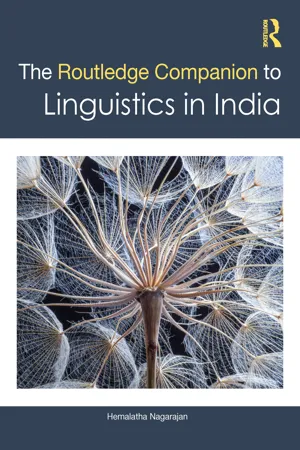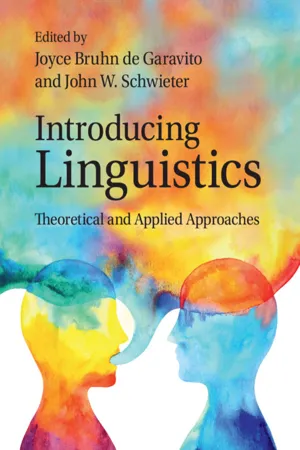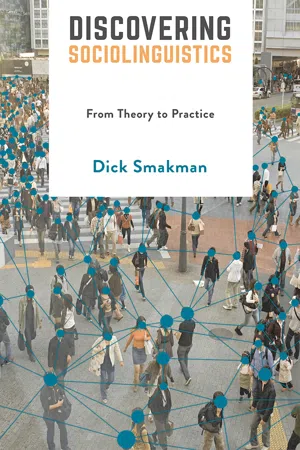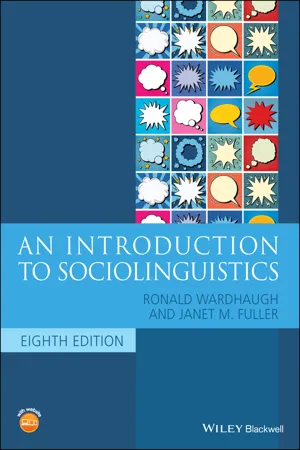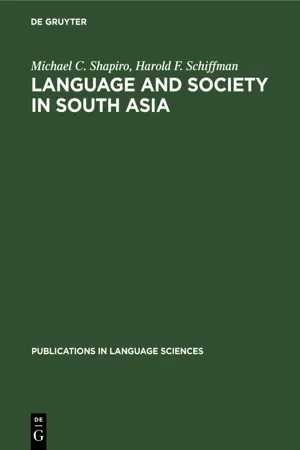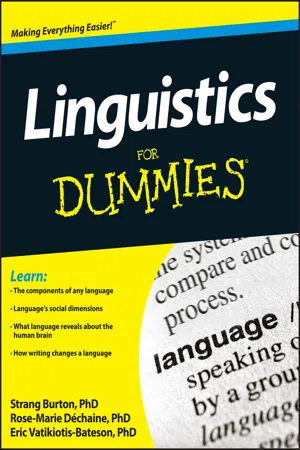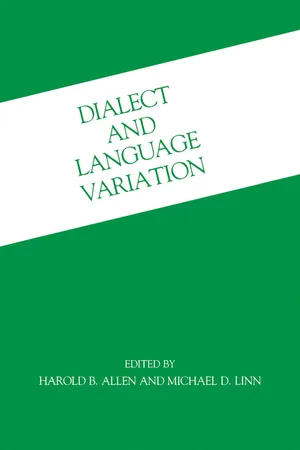Languages & Linguistics
Social Dialects
Social dialects refer to variations in language use that are associated with particular social groups, such as those based on region, ethnicity, or socioeconomic status. These variations can include differences in vocabulary, pronunciation, and grammar. Social dialects are influenced by factors such as social identity, cultural practices, and historical developments, and they play a significant role in shaping communication and language diversity within a society.
Written by Perlego with AI-assistance
Related key terms
1 of 5
10 Key excerpts on "Social Dialects"
- Victoria Fromkin, Robert Rodman, Nina Hyams, , Victoria Fromkin, Robert Rodman, Nina Hyams(Authors)
- 2018(Publication Date)
- Cengage Learning EMEA(Publisher)
Dialect differences that seem to come about because of social factors are called Social Dialects, as opposed to regional dialects, which are due to geographical factors. However, there are regional aspects to Social Dialects and, clearly, social aspects to regional dialects, so the distinction is not entirely cut and dried. Copyright 2019 Cengage Learning. All Rights Reserved. May not be copied, scanned, or duplicated, in whole or in part. Due to electronic rights, some third party content may be suppressed from the eBook and/or eChapter(s). Editorial review has deemed that any suppressed content does not materially affect the overall learning experience. Cengage Learning reserves the right to remove additional content at any time if subsequent rights restrictions require it. 278 CHAPTER 7 Language in Society The “Standard” We don’t talk fancy grammar and eat anchovy toast. But to live under the kitchen doesn’t say we aren’t educated. MARY NORTON, The Borrowers, 1952 Every language is a composite of dialects. But it is a widespread misconception that a language is a well-defined fixed system with various dialects diverging from this norm. One “language pundit” accused the editors of Webster’s Third New International Dictionary, published in 1961, of confusing “to the point of obliteration the older distinction between standard, substandard, colloquial, vulgar, and slang,” attributing to them the view that “good and bad, right and wrong, correct and incorrect no longer exist.” In the next section, we argue that such criticisms are ill-founded. Language Purists A woman who utters such depressing and disgusting sounds has no right to be anywhere— no right to live. Remember that you are a human being with a soul and the divine gift of articulate speech: that your native language is the language of Shakespeare and Milton and the Bible; and don’t sit there crooning like a bilious pigeon.- eBook - PDF
Language in Education
Social Implications
- Rita Elaine Silver, Soe Marlar Lwin(Authors)
- 2013(Publication Date)
- Bloomsbury Academic(Publisher)
Dialectology was revolutionized in the 1960s by the father of modern sociolinguistics , William Labov. Sociolinguistics is the study of how language works in a social context. At the time when sociolinguistics first was identified as a branch of linguistics, Labov did ground-breaking research that changed the way in which linguistic variation was studied. His findings are still important, and the methodology that he developed is a basic tool for sociolinguists studying language variation. Studies using Labov’s methodologies are often referred to as variationist sociolinguistics, social dialectology or Labovian sociolinguistics . Other social characteristics intersect with regional variation. Not everyone from the same place speaks in the same way. Every human being has multiple identities, and each aspect of identity can be expressed in a person’s speech. For example, the way we speak can indicate social class, gender, ethnicity, religion or educational attainment as well as regional origins. Any difference that is socially important is likely to be reflected in speech. Traditional dialectology focussed on regional variation, and not on differences between people from the same place. Traditional dialectologists did not examine the speech of people of higher social class or the speech of those who had a high level of education, because, in many societies, the speech of more prestigious groups does not vary as much from one region to another as does the speech of the less prestigious groups. This is one of the results of literacy and of the development of a standard dialect. Indeed, the spread of education was one of the things that inspired nineteenth-century dialectologists to undertake their research: They thought that dialectal variation would be destroyed by the increase in literacy. They were not quite correct: Dialectal variation continues to flourish, and new dialectal variation continues to develop (in the English of Australia, for example). - eBook - PDF
- Rowela S. Basa(Author)
- 2019(Publication Date)
- Society Publishing(Publisher)
Linguistic variation is generally associated with geographical areas. This chapter discusses some concepts of geographical variation in linguistics. This chapter also covers the significance of linguistic variation in English language essay. Finally, it discusses about linguist diversity and its complexity. 7.1. INTRODUCTION Language is not just a mode of communication between people. It is also considered as a social phenomenon. The whole branch which talks about language and society is known as sociolinguistics. It basically tries to reflect that how our language is affected by different factors like class, gender, race, etc. Anthropological linguistics is a subset of this area. It is basically concerned with different forms and usage of language in a different culture. It also talks about the influence of cultural environment in the development of language. Sociolinguistics is the branch which studies about the interconnection between language and society and the different ways people uses the language according to the social situations. Its inquiries about the basic question, “How does the social nature of human beings are affected by language, and how does language is affected by social interaction? There is a great variation of depth and detail in the languages whether we have studied the dialects across the different regions or when we analyzed the way men and women communicate in different situations. An author Raymond Hickey who wrote a book named as language and Society. He basically gave a statement about sociolinguistics which is basically the study of language and society is that this term is coined in the middle of the twentieth century. Before the twentieth century also, there were many authors who passed a comment that how usage of language was affected or indeed directed by social factors like profession, age, class or The Linguistic Variations and the Society 171 gender. - eBook - ePub
- Hemalatha Nagarajan(Author)
- 2022(Publication Date)
- Routledge India(Publisher)
The static factors are aspects like region, class, caste, gender, etc., of the speaker, which remain unaltered in all circumstances. 1 There are also some dynamic factors that condition our language use. These are factors like the subject matter, the medium of communication (spoken or written, e-mail, or text message), and the addressor–addressee relationship, fashions in language use, etc. The static factors mostly lead to dialects, and the dynamic factors contribute to differences in registers. A. Dialects Dialects are varieties of a language spoken by a group of people and are characterized by some systematic phonological, morphological, syntactic, or semantic features. Dialects are classified under two heads: regional and social. Figure 7.1 Dialects: regional and social Regional dialects differ according to the region they are spoken, whereas Social Dialects refer to the social structure and the differences in language that arise because of this. It could be in terms of race, social class, or caste differences. Wardhaugh (1986 : 22) defines language varieties, such as dialects, in terms of a specific set of linguistic items or human speech patterns (presumably, sounds, words, grammatical features) which we can uniquely associate with some external factors (presumably, a geographical area or a social group). Sociolinguists study the linguistic features of dialects and create dialect maps. A dialect is demarcated from others by a linguistic boundary called an isogloss. Frequently, however, several isoglosses are grouped approximately together into a bundle of isoglosses. Isoglosses of various linguistic phenomena usually cross and interweave creating dialect maps - eBook - PDF
Introducing Linguistics
Theoretical and Applied Approaches
- Joyce Bruhn de Garavito, John W. Schwieter(Authors)
- 2021(Publication Date)
- Cambridge University Press(Publisher)
PART 5 LANGUAGE AND SOCIAL ASPECTS OVERVIEW The goal of the present chapter is to familiarize you with key concepts and findings in sociolinguistics. More specifically, you will: • learn about language and society; • acquire concepts needed to study variation in the use of language; • discover factors relevant for how different people speak; • discover factors relevant for how individuals vary their speech; and • explore variation in bilingual societies. 9.1 What Is Sociolinguistics? The branch of linguistics which seeks to examine and explain the everyday variation that characterizes human languages is sociolinguistics. Linguistic variation not only refers to the fact that many different languages in the world are spoken by humans, but also refers to the variation within a given language and even within speech communities of that language. In other words, linguistic variation happens at many levels: between languages, within a language, and within individuals who speak those languages. We don’t always express the same information in the same way. You probably already have noticed just by being human that how people speak is based on factors like: • where they are from (regional variation); • who they are (age, gender, socioeconomic status, etc.); • the situation they are in (formal, informal); • their linguistic profile (bilingual, monolingual). Sociolinguistics studies the (often quantitative) relationships that exist between dif- ferent linguistic forms, and social and situational categories. Another way to understand what sociolinguistics investigates is to contrast it with other approaches to language, like structural and prescriptive perspectives. 9 Sociolinguistics Language in Society Terry Nadasdi 328 Sociolinguistics: Language in Society Structural approaches are interested in the invariable properties of language (i.e., what is and isn’t possible in a given language). - eBook - PDF
Discovering Sociolinguistics
From Theory to Practice
- Dick Smakman(Author)
- 2017(Publication Date)
- Bloomsbury Academic(Publisher)
The term can be used generically to avoid unwanted distinctions between less codified and more codified lan-guages (‘dialects’ and ‘standard languages’ are all ‘varieties’, and so are, for instance, occupational varieties involving jargon). Some of the terms include the syllable ‘lect’, which refers to a set of linguis-tic phenomena that can be recognised as an entity. A ‘sociolect’ is a variety defined on the basis of social grounds and is associated with a group of people who share certain qualities. For instance, in a Tamil-speaking region in India there are two sociolects, namely Mudaliyar and Iyengar. Mudaliyar is spoken by a lower caste than Iyengar, as the latter caste is associated with scholarli-ness. This is a social (rather than a regional) difference between the groups. There are also internationally known sociolects, like so-called ‘Valley speak’, or ‘Valspeak’, as well as ‘Surfer talk’, which are typical of younger speakers in Southern California in the United States (Macías et al. 2018 ). ‘Hyperlect’ is a name sometimes used for a certain sociolect, namely posh speech (Honey 1985 ). Poshness refers to a sociolect that is characterised by distinctive word choices and ways to pronounce certain sounds and certain words. A ‘regiolect’, which often has a name, is defined on the basis of geographical criteria. Latgalian, as spoken in Eastern Latvia, is a regiolect. An individual’s unique language sys-tem, i.e., one’s personalised variety, is often referred to as an ‘idiolect’. The term ‘idiolect’ is closely related to the word ‘vernacular’, which refers to the language used for everyday communication, i.e., a spontaneous language that comes naturally. The latter term is often also used to refer to a group’s indigenous language, especially if that deviates from a wider language norm. ‘African American Vernacular English’, an urban vernacular from the United States, fits that particular meaning of the term. - eBook - PDF
- Ronald Wardhaugh, Janet M. Fuller(Authors)
- 2021(Publication Date)
- Wiley-Blackwell(Publisher)
Languages, Communities, and Contexts 56 patterns in data which link social factors with language use without ignoring variation within groups and the specific practices and experiences that make up individual identities. After our discussion of speech communities, social networks, and communities of prac- tice, we will link these ideas about how we might define social groups with a framework for studying social identities in order to provide a bridge between individual repertoires and social categories. The final section of this chapter then moves on to look at how people view these social groups and the ways of speaking associated with them, looking at lan- guage attitudes, language ideologies, and perceptual dialectology studies. Speech Communities Sociolinguists have offered different interpretations of the concept of the speech commu- nity. We are faced with the dilemma of wanting to study groups of language users but lack- ing a clear definition of what comprises a group. We will discover that just as it is difficult to define such terms as language, dialect, and variety, it is also difficult to define speech community, and for many of the same reasons. Nevertheless, this concept has proved to be invaluable in sociolinguistic work in spite of a certain ‘fuzziness’ as to its precise characteristics. Linguistic boundaries In sociolinguistics, we need a specific definition of a group in order to do research. The kind of group that sociolinguists have generally attempted to study is called the speech community (see Patrick 2002 and Morgan 2001, 2004, for a general survey of the research). For purely theoretical purposes, some linguists have hypothesized the existence of an ‘ideal’ speech community. However, such a speech community cannot be the concern of sociolinguistics: it is a theoretical construct employed for a narrow purpose. - eBook - PDF
- Michael C. Shapiro, Harold F. Schiffman(Authors)
- 2019(Publication Date)
- De Gruyter Mouton(Publisher)
They hold similar religious beliefs and regularly exchange services. Yet, although they are in constant communication, they may speak distinct languages and dialects at home. Whereas, in other areas of the world, intergroup communication in time tends to obliterate language differences, in India such differences appear to be in large part maintained (Gumperz, 1969b :598). Although linguists as far back as Bloch have recognized the pivotal role played by social variables in determining types of linguistic variation, most have been at a loss in coming up with coherent theoretical frameworks for describing complex sociolinguistic phenomena. Those attempts that have been made were hampered by inadequate theories for dealing with the range of sociolinguistic variation, by a failure to appreciate how linguistic innovations and subjective attitudes towards linguistic variation are transmitted, and by inadequate descriptive theories of the chains of communication that link the members of speech communities. In addition to the above points, Gumperz raises a question that has been of central concern in almost all studies of Social Dialects in South Asia: what are the mechanisms by which correlations between linguistic and social variables are maintained ? Many early studies of socially deter-mined variation in language assumed the truth of Bloomfield's dictum that differences in linguistic code are associated with different patterns of social interaction — that groups that exhibit the greatest linguistic differences are those most isolated from one another (Bloomfield, 1933:47). As Susan Bean points out, the Bloomfieldian view of dialect w'as developed primarily with regional variation in mind, where rivers, mountains, and political boundaries separate groups and promote the development of linguistic differences. His view of Social Dialects is that isoglosses correspond to places in the social structure where communication is infrequent. - eBook - PDF
- Rose-Marie Dechaine, Strang Burton, Eric Vatikiotis-Bateson(Authors)
- 2012(Publication Date)
- For Dummies(Publisher)
When a speaker identifies with a group that isn’t present, linguists call this initiative style-shifting ; the absent group is called a referee group. Playing your role as a speaker As a speaker, you play a role with respect to your audience; this is your role relation . When shifting styles to play a role, you use one of two strategies: ✓ You shift your style away from your audience. You can imitate a dialect that isn’t part of your everyday conversation or your audience’s — linguists call this dialect-performance . You may do this to express solidarity with the group that’s associated with that dialect or sociolect (the speech variety linked with social features such as age, class, gender, and occupation). Linguists call this divergent linguistic behavior . ✓ You shift your style towards your audience. An example of this is when language teachers accommodate their speech to the level of their stu-dents. Linguists call this convergent linguistic behavior . A lect is a variety of speech. The speech variety of a single individual is an idiolect . A dialect is the speech variety of a regional area. A sociolect (also called social dialect ) is the speech variety linked with social features such as age, class, gender, and occupation. A genderlect is the speech variety associ-ated with gender — for example, linguists compare the female genderlect with the male genderlect. Variationist analyses focus on the linguistic variables associated with speak-ing styles. In anthropological linguistics, speaking styles are part of the ethnography of communication , which looks at how ways of speaking reflect social structures. 170 Part III: The Social Life of Language Chapter 10 Finding Family Relations: Historical Linguistics In This Chapter ▶ Discovering why language changes ▶ Digging into Indo-European ▶ Finding language families L anguages, like siblings, often resemble other languages from the same language family. - eBook - PDF
- Michael D. Linn(Author)
- 2014(Publication Date)
- Academic Press(Publisher)
It depends as well on a complex of linguistic, articulatory and perceptual factors. In the discussion that follows we shall attempt to confirm this hypothesis by investigating, on the one hand, recent descrip-tions of the phonological differences among Social Dialects and, on the other hand, the evidence that has become available concern-ing the ideological motivation for these differences. We shall discover that popular dialects exhibit their greater susceptibility to phonetic conditioning in such features as simplified articulation, replacement or loss of perceptually weak segments, and a greater tendency to undergo 'natural 1 vowel shifts. 6 As far as ideology is concerned, we shall see that there is both experimental and historical evidence that prestige dialects require special attention to speech, attention motivated not by the needs of communication but by status consciousness. CURRENT THEORY OF DIALECT DIFFERENTIATION Before we proceed with our argument, let us clarify the difference between our hypothesis and others' explanations for social dialect variation. In particular, we must state explicitly 346 Anthony S. Kroch the relationship between our views and those of Labov, since his work provides so much of the empirical material available to theoret-ical reflection. Labov's research has generated considerable evidence for the proposition that working-class speech is more susceptible to the processes of phonetic conditioning than is the prestige dialect. unfortunately, Labov and other contemporary sociolinguists neither state this principle explicitly nor attempt to provide an explanation for it. Indeed, Labov is not willing to make a clear empirical claim on the linguistic character of social dialect variation. His theoretical statements sometimes point towards our characterization of social dialect differences, but on other occasions he seems to take a position contrary to our proposal.
Index pages curate the most relevant extracts from our library of academic textbooks. They’ve been created using an in-house natural language model (NLM), each adding context and meaning to key research topics.



